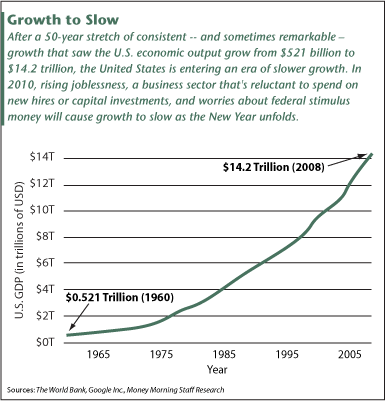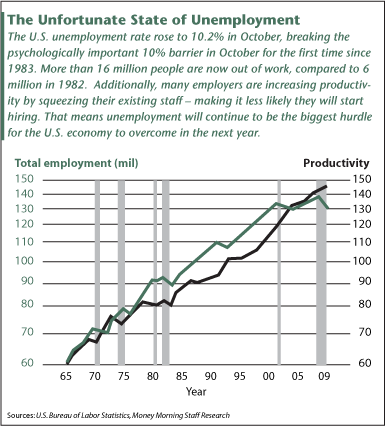2009 was a wild year for the economy. The stock market soared, but the U.S. economy was hampered by rising unemployment and tight credit markets.
What will 2010 bring? Find out the four major trends to watch for in 2010... and where to look for real gains.
The S&P 500 has rocketed over 60% from its March 2009 lows, and economists are more confident than ever that the U.S. will dodge the dreaded "double dip" recession.
But don't uncork the champagne yet.
The U.S. economy will grow in 2010, but we won't see anything close to the incredible growth that was the hallmark of the pre-recession "bubble" economy. The problems of the last year - high unemployment, tight credit markets, inflationary fears - haven't been fixed... and some could get worse before they get better.
We pulled together our expert staff of former investment bankers, international financiers and veteran financial journalists to find out where they think the U.S. economy is headed in 2010. Read on for their predictions... and to find out exactly where to find profits in the year ahead.
Prediction #1: U.S. Growth Will Decelerate as 2010 Progresses
Forecasters are reluctant to forecast a sharp economic rebound in 2010. As opposed to a classic "v-shaped" recovery that would accelerate as the year goes on, many economists predict that the rate of growth will actually slow in 2010.
Standard & Poor's recently projected average GPD growth of 1.6% for all of 2010. Goldman Sachs projects the U.S. growth rate to decline from 3% early in the year to 1.75% by the fourth quarter.
Among the difficulties economists face is that fact that 4% of the economic growth in recent months is directly attributable to temporary factors - most notably, the replenishing of inventories and government fiscal stimulus. These factors are likely to diminish as 2010 wears on, thanks to high unemployment, budget-conscious consumers, and overcapacity in the manufacturing sector and housing markets.
Overall, the consensus estimate of 52 economists polled by the Blue Chip Economic Indicators newsletter is that the U.S. economy will expand 2.7% next year.
But, this may be overly optimistic.
The U.S. economy "will be lucky to do 2.0%" next year, predicts Money Morning's Chief Investment Strategist Keith Fitz-Gerald. "The economy faces some very difficult challenges. There's a slight chance - depending on what happens with some outside factors - that the U.S. could do 2.5%, but I really doubt it."

That's not to say that 2.0% growth is bad news. That's more than enough to negate the odds of a double-dip recession - where the economy recovers for a while before dipping back into recession.
Overall, we believe the U.S. will likely experience slow GDP growth ranging between 1.0% and 2.0% for all of 2010. The growth rate will decelerate as the year progresses, as a protracted jobless recovery extends the housing and banking crisis, puts a damper on wages, and reduces consumption.
Prediction #2: The "Jobless Recovery" Will Stifle Consumer Spending
The U.S. economy is largely consumer driven, spurring 60-70% of U.S. growth.
"We need households to become a little more confident and businesses to start thinking about tomorrow so we can transition out of the government- and Fed-supported economy into a private-sector recovery," said Joel Naroff, president of Naroff Economic Advisors in a note to investors.
But, this is unlikely to happen as long as consumers have trouble securing jobs.
The U.S. unemployment rate broke the psychologically important 10% barrier in 2009 for the first time since 1983. And the unemployment picture is actually much worse than it appears. When you factor in part-time workers who'd prefer to work full-time and people who have given up looking for a job, the "real" unemployment rate is actually a record-high 17.5%.

At the same time, productivity is increasing as employers are successfully getting their existing staff to produce more in fewer hours. This makes it less likely that they will start hiring soon.
It's no surprise that U.S. consumers are cutting their spending.
The recession may technically have ended, but for the millions of unemployed workers, the hard times are far from over. Given that almost one-fifth of the U.S. workforce is out of work or underemployed, don't expect consumers to step in if stimulus spending falls short.
Prediction #3: Business Spending and Hiring Won't Pick Up in 2010
56% of U.S. companies say they are still being adversely affected by credit-market conditions. Among those negatively affected, two-thirds say the cost of credit is their biggest problem, and half say credit is simply less available. This can't help but stifle growth.
U.S. businesses have embraced a leaner, lower-cost mindset that leaves firms reluctant to hire and reticent about making capital investments other than those that can't be avoided. That will prolong the jobless recovery, and result in lower contributions to U.S. GDP growth by both consumers and businesses.
Most firms will take several years to return to pre-recession employment levels and some expect to operate with permanently reduced workforces. Unemployment could reach 10.5% before leveling off in the third quarter of 2010.
Small businesses, which employ more than half of all private-sector workers, are not even close to picking up the slack.
In fact, 16% of small-business owners surveyed by the National Federation of Independent Business said they are planning to cut jobs in the next three months - nearly double the number planning to add jobs.
"The ‘job-generating machine' is still in reverse," the federation said.
But there may also be a silver lining: With this newfound frugality, companies should be able to maintain - or even boost - profitability. That could be good for U.S. stock prices and for the ongoing stock market rebound.
Prediction #4: The Fed Will Be Handcuffed by Unemployment
In its effort to jump-start the economy, the government has already put up $3.27 trillion in stimulus programs.
However, only about a third of the $787 billion stimulus package has hit the U.S. economy, according to Standard & Poor's Inc. Most infrastructure spending is just now getting started after being delayed by the political process.
In addition, the Federal Reserve has kept the benchmark Federal Funds rate for overnight lending to banks at between zero and 0.25% since last March. They've also promised to keep rates "exceptionally low" for "an extended period."
The unemployment rate has never peaked inside a recession and the Fed has never raised interest rates while unemployment was still rising. That means all signs point to the Fed keeping rates low until unemployment begins to subside.
But what does this mean for inflation?
Right now, the consensus is that inflation fears are unwarranted. However, overall producer prices increased 0.3% in October - powered by big jumps in food and energy prices.
Could the policies being followed now fan the flames of inflation? Even worse, could it lead to stagflation - a situation where inflation comes while unemployment stays high?
One thing is for certain: Fed policymakers are in a tough spot. If they raise rates too soon, they risk choking the recovery. But if they wait too long, they could spawn ruinous inflation and possibly even stagflation. We think they'll opt to keep rates low as long as unemployment continues to rise.
How to Make Money in 2010
Overall, the economy appears to be on the path to progress... But that path looks like a long one. In the mean time, look outside the U.S. stock market - to commodities and foreign markets.
Money Morning Contributing Editor Peter Krauth thinks spectacular gains are in store for gold and silver stocks. Consider the SPDR Gold Trust (NYSE: GLD). Each Share of GLD represents 1/10 th of an ounce of gold. It's highly liquid, and provides you with the quickest and easiest way to get exposure to gold.
Investing in silver could be an even better option: The metal is currently trading at less than 15% of its 1980 high, the equivalent of $130 per ounce. The iShares Silver Trust ETF (NYSE: SLV) is the best way to play silver directly.
Outside of commodities, consider investing in non-U.S. companies. Money Morning's Fitz-Gerald thinks opportunities abound in China. "Eventually, all roads will lead to China," he says.
Investors might want to consider the U.S. Investors China Region Fund (MUTF: USCOX) . The fund focuses on enterprises registered and operating in China and the China region. At least 80% of the fund's assets are invested in equity securities and depository receipts of companies located in the China region. The fund also invests in securities that trade directly on the Hong Kong, Shenzhen, and Shanghai stock exchanges, as well as the Taiwan, Korea, Singapore, Malaysia and Indonesia stock exchanges. The fund is up more than 37% year to date, and annualized five year returns have averaged 10.5%.
Another hot market for 2010 is South Korea. As Money Morning Contributing Editor Martin Hutchinson says, "Korea's true investment allure: The country is well run." Consider the iShares South Korea ETF ( AMEX: EWY ), which invests in the Morgan Stanley Capital International Korea Index. It has a P/E ratio of 13, but a yield after expenses of only 0.8%. Or, look at Posco (NYSE ADR: PKX), Korea's largest steel company. Posco is the world's No. 3 steelmaker, and is the most efficient in terms of output/man hour.
News and Related Story Links:
- Money Morning:
Although President Obama Warns of a "Double-Dip" Recession, Money Morning Expects U.S. Recovery to Continue
- Money Morning:
Low November Job Losses Shock, but The Jobless Recovery Continues
- Wall Street Journal:
Bernanke Says Rates Will Stay Low for Extended Period
- Wall Street Journal:
Jobs Data Lift Recovery Hopes
- Standard & Poors:
U.S. Economic Forecast: Panic Is Being Replaced by Fear
- MSN Money:
What Comes After 10% Unemployment?


